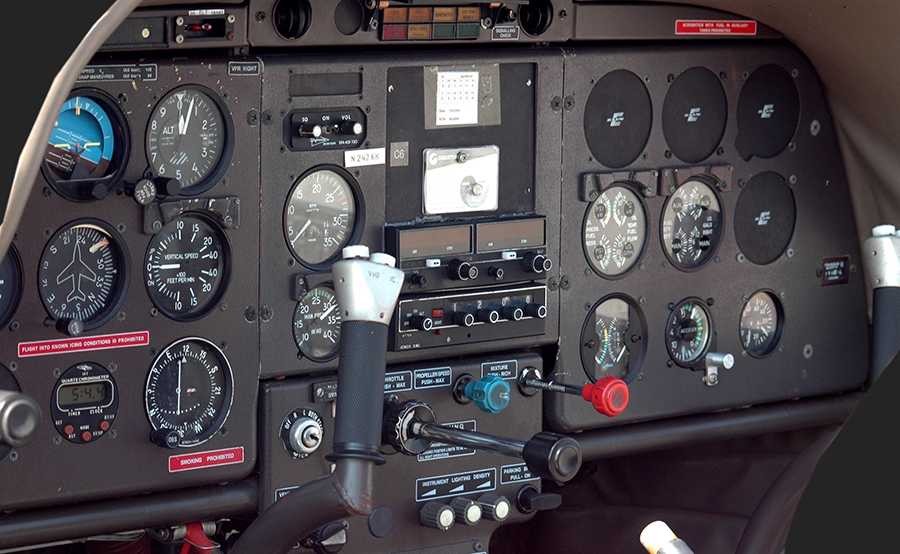-
Key Takeaways
-
Stalls Cause a Loss of Lift
-
What Is a Stall in Aviation?
- Critical Angle of Attack
-
What Causes an Aircraft to Stall?
- High Angle of Attack
- Low Airspeed
- Abrupt Maneuvers
- Types of Stalls
-
How Do Pilots Recover From a Stall?
- Recognizing Warning Signs
- Avoiding a Secondary Stall
- Importance of Stall Training
-
Why Do Pilots Practice Stalls?
- Training Altitudes and Safety
- Required Pilot Skills
-
Common Misconceptions About Stalls
- Stall Misconceptions
- Why Stalls Can Happen in Any Aircraft
- Common Fears for New Pilots
-
Conclusion
Do you know what causes aerodynamic stalls and how to prevent them? Let’s break it down: An aerodynamic stall occurs when the wing exceeds its critical angle of attack. This can happen to any airplane type.
The recovery procedure often involves coordinated actions, including adding power and leveling wings. Understanding the mechanics of wings is key to overcoming stalls successfully.
Keep yourself educated and self-assured in your flying abilities—keep reading for tips on how to handle stalls.
Key Takeaways
- An aircraft stall occurs when a wing exceeds its critical angle of attack.
- Stall recovery requires lowering the nose, leveling wings, and adding power.
- Every pilot must master stall recognition and recovery techniques.
- Stalls can happen at low or high airspeeds and in any flight attitude.
Stalls Cause a Loss of Lift
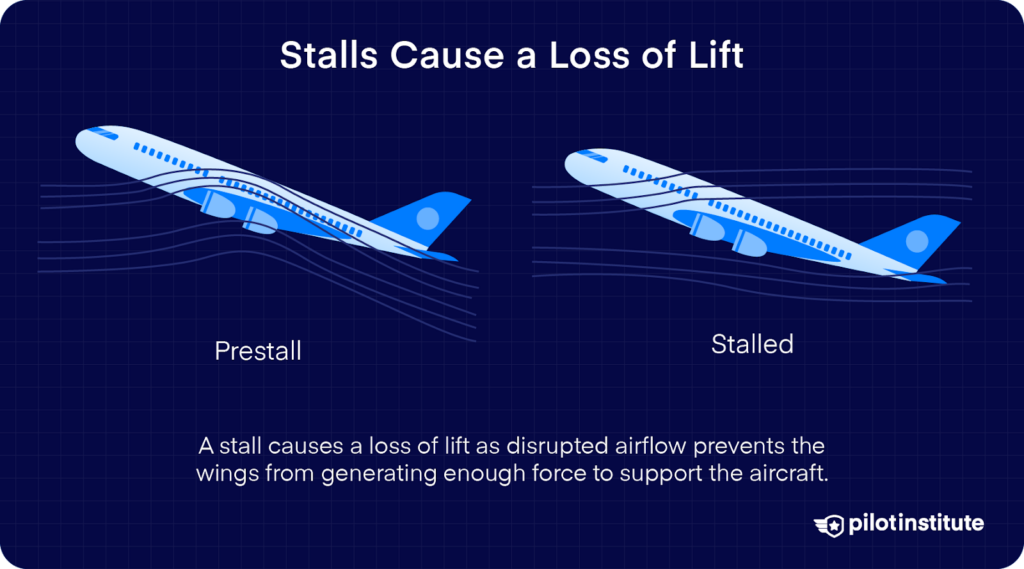
A stall is not related to engine failure. Many people unfamiliar with aviation hear the term stall and mistakenly think it refers to a car engine dying. However, in aviation, an aircraft can experience a stall even when the engine is operating at full power.
This misunderstanding can lead to confusion and, in some cases, accidents, as some pilots concentrate on engine performance instead of addressing the actual problem, a loss of lift.
What Is a Stall in Aviation?
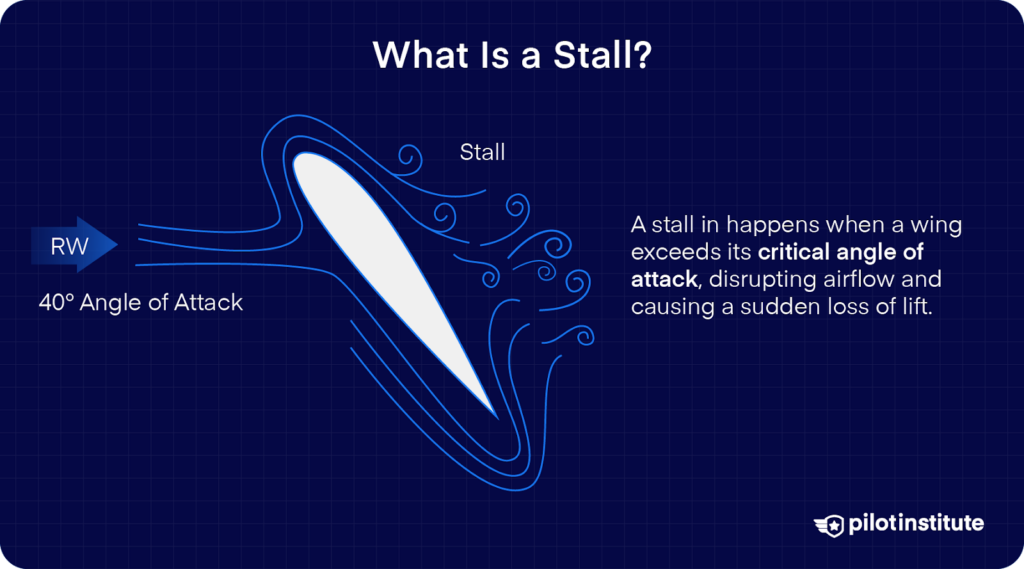
Imagine that the aircraft’s wing is like putting your hand out of a car window. When you keep it flat, the air flows smoothly above and below. If you tilt your hand upward slightly, you can feel an increase in lift – but if you tilt it too much, the airflow becomes turbulent, and lift suddenly decreases.
This tilting motion is similar to how the angle of attack (AOA) works on an aircraft wing. But how does it occur in actual flight? The AOA is the angle between the wing’s chord line and the oncoming airflow.
Critical Angle of Attack
As the AOA increases, the wing generates more lift, but only up to a specific point known as the critical angle of attack, typically around 15-20 degrees for general aviation aircraft (though this can vary depending on the wing design).
When you exceed the critical angle of attack, the airflow over the wing becomes disrupted, leading to a loss of lift and resulting in a stall.
What Causes an Aircraft to Stall?
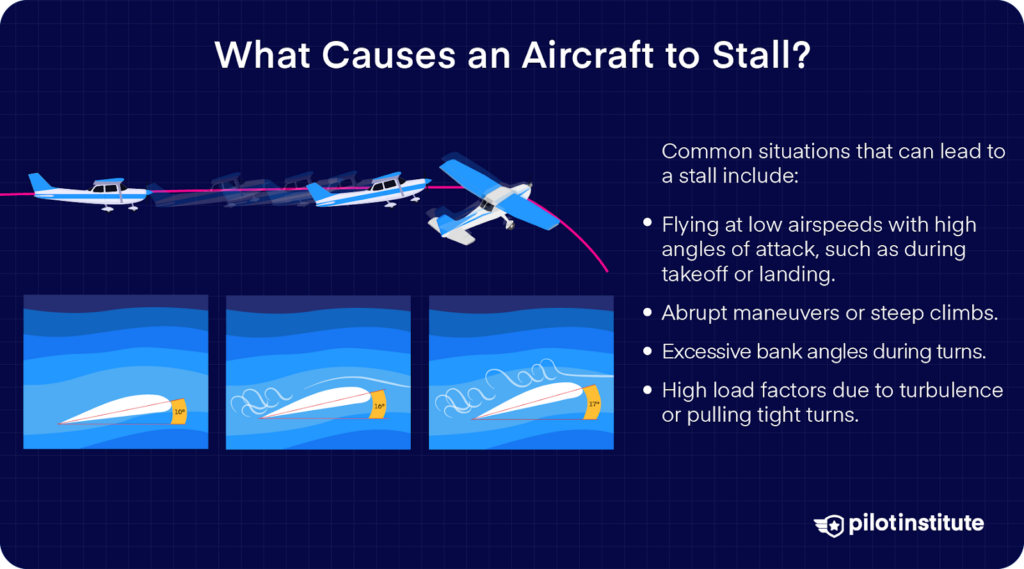
It’s important to know that several factors can contribute to a stall. That’s why a basic understanding can help you identify the warning signs early on:
High Angle of Attack
A stall is caused by exceeding the critical angle of attack. This can occur during steep climbs, tight turns, or when you pull back too forcefully on the control yoke.
Low Airspeed
When you fly at low airspeeds, there’s less air moving over the wings to generate lift. To counteract this decrease in airflow and maintain the same lift, you must increase the wing’s angle of attack. This brings you closer to the critical angle of attack, which increases the chances of a stall.
Speed Misconception
Many think that stalls only happen at low airspeeds. The reality is that an aircraft can stall at any airspeed. Why is that? While the main reason for a stall is surpassing the wing’s critical angle of attack, the airspeed influences when this angle is reached.
For instance, at higher airspeeds, sudden maneuvers like sharp bank angles or pull-ups are needed to trigger a stall.
Abrupt Maneuvers
When you execute a maneuver such as a steep turn or a sudden pull-up, the aircraft experiences an increase in load factor, which is measured in Gs (acceleration of gravity).
For example, during a 60-degree banked turn, the aircraft weighs twice as much due to the load factor (2Gs). Now, the wings have to produce more lift to support this weight.
To do that, the wing has to operate at a higher angle of attack. Remember that the critical angle of attack stays constant, so now there’s a lower margin before reaching and exceeding that angle.
This is why an aircraft can stall at higher airspeeds during abrupt maneuvers, a situation known as an accelerated stall.
Types of Stalls
So, what stall situations might you encounter while flying? These are the different types of stalls you should train for and become familiar with:
1. Power-off stalls simulate landing scenarios, where you reduce power and gradually raise the nose to maintain altitude.
2. Power-on stalls mimic takeoff or go-around situations, taking place at full power with a steep climb angle.
3. Accelerated stalls take place during steep turns or abrupt maneuvers.
4. Secondary stalls happen when you pull back on the controls too aggressively during recovery, causing the angle of attack to go beyond the critical limit again.
How Do Pilots Recover From a Stall?
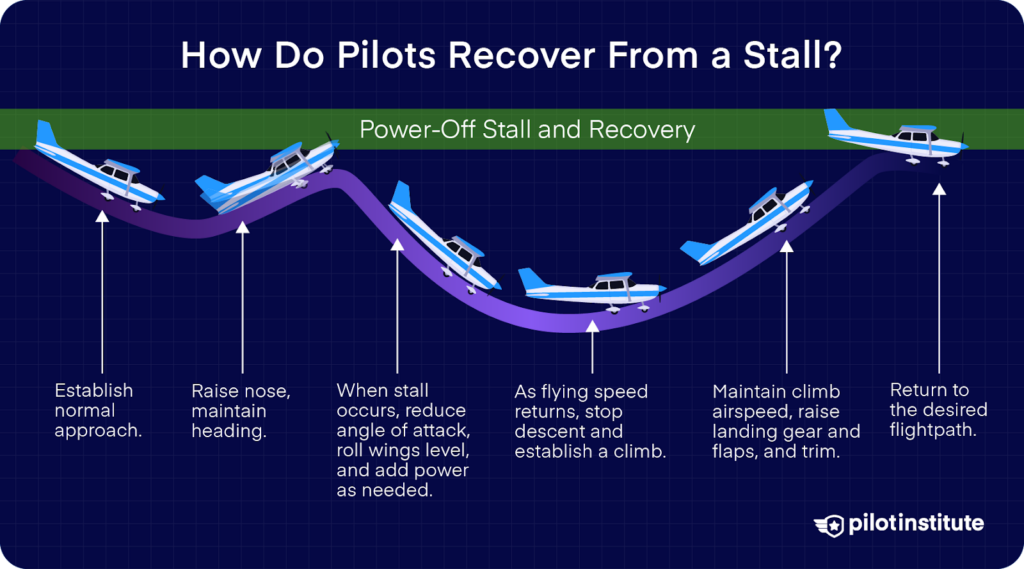
Stall recovery focuses on restoring smooth airflow over the wings by reducing the angle of attack. Based on the aircraft type, your instructor will provide the required hands-on training.
This is a stall recovery procedure that is effective in most scenarios:
- Reduce the angle of attack: Push forward on the control yoke.
- Level the wings: Use coordinated rudder and aileron inputs.
- Apply full power: Increase the throttle to full.
- Gently climb out: As airspeed increases, smoothly raise the nose to return to a safe climb attitude.
- Return to normal flight: Once fully recovered, re-establish the desired altitude, heading, and airspeed.
While this sequence may seem straightforward, it requires practice to execute effectively, especially when close to the ground where altitude space is limited. The instinctive reaction during a stall is often to pull back on the controls, which will make the situation worse.
Recognizing Warning Signs
During your pilot training, the instructor will intentionally induce stalls at safe altitudes. These practice sessions are vital for helping you recognize stall warnings, such as:
- Quieter cockpit.
- Reduced control effectiveness(mushy controls).
- Aircraft buffeting.
- Stall warning horn.
Avoiding a Secondary Stall
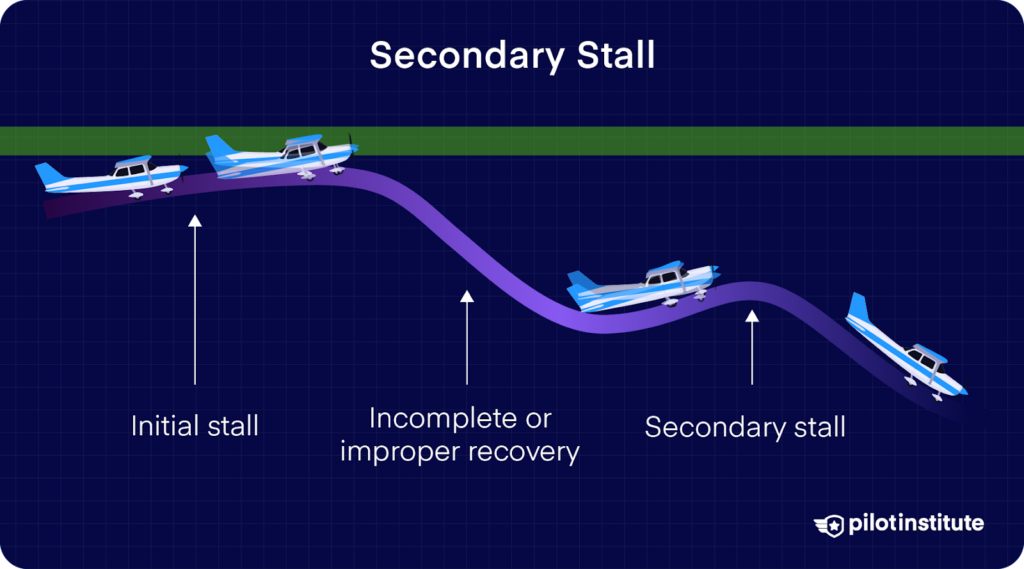
A secondary stall occurs after recovering from an initial stall, often due to raising the nose too quickly, especially at low altitudes. It happens when the critical angle of attack is exceeded again, usually from insufficient pitch reduction or relying solely on power for recovery.
Importance of Stall Training
How does consistent stall practice help reduce anxiety? Proper training can turn stall recovery from a panicking situation into a manageable task.
Consider learning to ride a bike. Initially, the feeling of losing balance can be frightening. However, with practice, regaining your balance becomes instinctive.
The same idea applies to stall recovery. Through consistent practice, you can build more confidence. Over time, you will learn to rely on your instruments, understand the aircraft’s unique stall characteristics, and carry out recovery procedures confidently.
Note: To determine the right stall recovery technique for your aircraft, consult the Pilot Operating Handbook (POH). It provides the most relevant information for your specific aircraft model and configuration.
Why Do Pilots Practice Stalls?
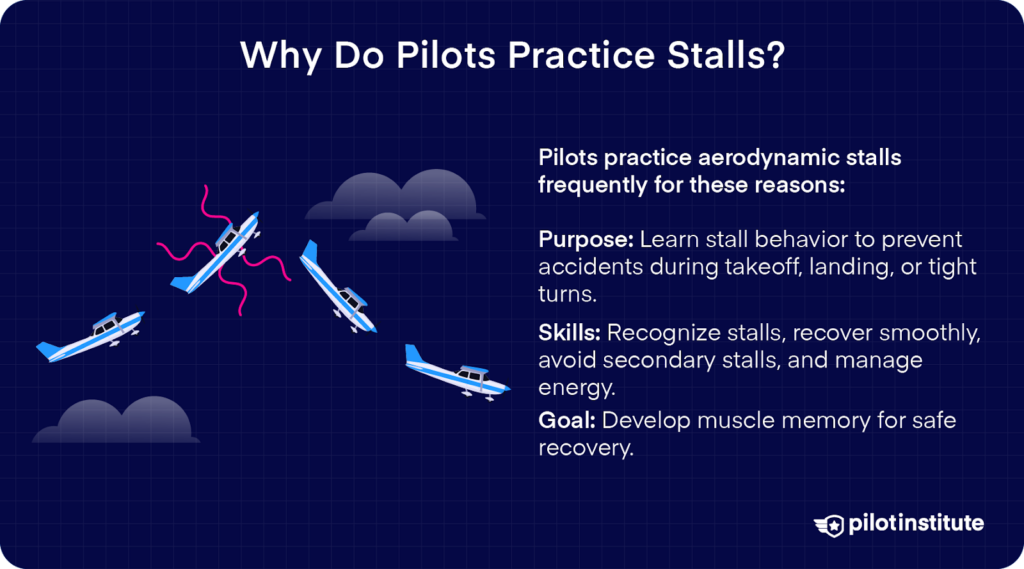
The FAA mandates stall practice for important reasons. As a pilot, you must grasp how your aircraft reacts during a stall. This training can help prevent accidents during important flight phases, such as takeoff, landing, or tight turns where stalls can pose significant risks.
Training Altitudes and Safety
What’s a safe altitude to train? You should conduct training sessions at or above 1,500 feet AGL. Remember that the training altitude can vary based on your aircraft type and specific training guidelines.
Your instructor will show you various stall types and recovery methods and teach you how factors like weight, bank angle, and power settings influence stall behavior.
More importantly, with regular practice, you will develop the muscle memory necessary for effective stall recovery.
Required Pilot Skills
Beyond just performing these maneuvers, the FAA requires pilots to demonstrate specific skills:
- Recognition of stall warning signs in all configurations.
- Proper use of pitch, bank, and power during recovery.
- Clean recovery without secondary stalls.
- Managing the aircraft’s energy throughout the maneuver.
Common Misconceptions About Stalls
Let’s clarify some common misconceptions about aircraft stalls:
Stall Misconceptions
“Stalls Only Happen To Inexperienced Pilots”
This is incorrect. Stalls can occur to any pilot if the conditions for a stall exist such as exceeding the critical angle of attack, regardless of experience.
“Stalls Are Caused by Engine Failure”
That’s not accurate. Stalls are related to the angle of attack, not engine power. An aircraft can stall even at full throttle if the critical angle is exceeded.
Why Stalls Can Happen in Any Aircraft
From the Cessna to the Boeing, every aircraft can experience a stall. This is a fundamental principle of aerodynamics. All wings, no matter their size or design, have a critical angle of attack.
When this angle is surpassed, the aircraft will stall. Does engine power matter? While engine power cannot prevent a stall, it can assist in recovery by helping regain airspeed and reduce altitude loss.
Common Fears for New Pilots
For many new pilots, stalls can cause anxiety due to concerns about control, warning signs, or altitude loss. This anxiety usually stems from:
Fear of Loss of Control
Many new pilots worry they won’t be able to recover from a stall. However, modern training aircraft are designed to be stable and predictable during stalls.
Fear of Sudden Onset
Students often fear that stalls will happen without warning. In reality, aircraft provide multiple warnings before a stall occurs. You’ll feel buffeting, hear the stall warning horn, and notice control mushiness.
Fear of Height Loss
While it’s true that recovering from a stall involves some altitude loss, this happens in a controlled manner. For your safety, stall training is conducted at safe altitudes to make sure you can recover easily.
Conclusion
So now you know what a stall is. If you’re planning on becoming a pilot, your instructor will demonstrate a stall during your training to help you understand how it happens. Take the time to make sure you fully understand how to recover from a stall.
You can learn more about stalls with our course Private Pilot Made Easy.

